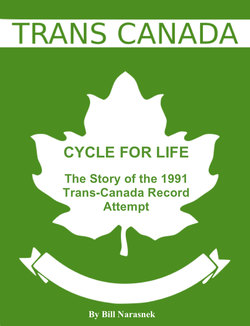Читать книгу Cycle For Life: The Story of the 1991 Trans-Canada Record Attempt - Bill Psy.D. Narasnek - Страница 7
На сайте Литреса книга снята с продажи.
THE RECORD
ОглавлениеWhat was, and often still is, misunderstood about the Trans-Canada record, by people not knowledgeable about the sport, is the formality of the attempt. In order to be fair, consistent, and legitimate, any record must have a defined structure. It is not simply a matter, of anyone who wishes, hopping on their bike and having a go!
The Trans-Canada cycling record comes under the sanctioning authority of the Canadian Cycling Association, the governing body for the sport of cycling in Canada.
Rules for record attempts incorporate regular bicycle racing rules along with special rules laid down specifically for that purpose. The most pertinent of these rules are that the record is to be attempted from the steps of city hall in Vancouver to the steps of city hall in Halifax and must follow roads solely in Canada for the entire distance. Support vehicles must remain at specified distances from the rider and no pacing or drafting of any kind is allowed. The event is timed and officiated by an official (commissary), who is licensed to do so.
The rider must have a racing license and pays a $100 sanctioning fee. Once a start date is approved the rider has an 8 day "window" from that date to start his or her attempt. It is, in essence, a 6000 kilometre time trial. The clock starts in Vancouver and does not stop until Halifax. Any breaks, rest, or sleep time is counted into the record.
At the time of our attempt the record was 13 days, 15 hours, 4 minutes and was held by Ron Dossenbach of Windsor, Ontario.
